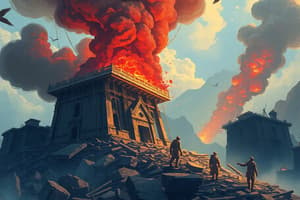Podcast
Questions and Answers
What was the primary long-term consequence of the 2005 earthquake regarding orphaned children in the affected regions of Pakistan?
What was the primary long-term consequence of the 2005 earthquake regarding orphaned children in the affected regions of Pakistan?
- International aid organizations successfully implemented programs to reunite orphans with surviving relatives, minimizing long-term displacement.
- The Pakistani government established new, secular orphanages to accommodate the increased number of children without families.
- A significant number of orphaned children were placed in fundamentalist madrasas due to the overwhelming destruction of family structures. (correct)
- The majority of orphaned children were adopted by families in other parts of Pakistan, leading to a rapid integration into new communities.
How did the Tehrik-e-Nifaz-e-Sharia-e-Mohammadi (TNSM) initially present themselves to the communities affected by the 2005 earthquake?
How did the Tehrik-e-Nifaz-e-Sharia-e-Mohammadi (TNSM) initially present themselves to the communities affected by the 2005 earthquake?
- As a helpful organization that helped with providing aid, leading prayers, clearing villages and burying the dead. (correct)
- As a military force establishing control over the affected areas and enforcing strict religious codes with immediate punishments.
- As primarily political advocates pushing for immediate implementation of Sharia law, sparking controversy among the affected population.
- As a foreign aid group distributing resources, but with a clear agenda of converting locals to their specific interpretation of Islam.
What specific vulnerability of the Pakistani population did the TNSM exploit following the 2005 earthquake to advance their agenda?
What specific vulnerability of the Pakistani population did the TNSM exploit following the 2005 earthquake to advance their agenda?
- The population's heightened sensitivity to perceived divine retribution, using it as a tool to promote stricter islamic law. (correct)
- The widespread desire for a more secular government that adhered to international human rights standards.
- The public's reliance on foreign aid, which the TNSM criticized as undermining national sovereignty.
- The pre-existing strong support for secular education, which the TNSM aimed to replace with religious madrassas.
In what crucial way did the scale of the 2005 earthquake challenge traditional Pakistani societal norms regarding orphaned children?
In what crucial way did the scale of the 2005 earthquake challenge traditional Pakistani societal norms regarding orphaned children?
What was the most critical factor that allowed religious groups such as the TNSM to increase their influence in the aftermath of the earthquake?
What was the most critical factor that allowed religious groups such as the TNSM to increase their influence in the aftermath of the earthquake?
What long-term effect did the influx of international aid following the 2005 earthquake have on the region, beyond immediate disaster relief?
What long-term effect did the influx of international aid following the 2005 earthquake have on the region, beyond immediate disaster relief?
In the context of the text, what was the most significant implication of the TNSM’s interpretation of the earthquake as 'a warning from God'?
In the context of the text, what was the most significant implication of the TNSM’s interpretation of the earthquake as 'a warning from God'?
Considering the social and political climate of Pakistan after the 2005 earthquake, what was the most significant challenge in ensuring aid reached its intended recipients?
Considering the social and political climate of Pakistan after the 2005 earthquake, what was the most significant challenge in ensuring aid reached its intended recipients?
Flashcards
2005 Earthquake
2005 Earthquake
A devastating earthquake in Pakistan measuring 7.6 on the Richter scale.
TNSM
TNSM
Tehrik-e-Nifaz-e-Sharia-e-Mohammadi, a conservative religious group in Pakistan.
Orphaned Children
Orphaned Children
Children left without parents due to the earthquake.
Madrasas
Madrasas
Signup and view all the flashcards
Divine Punishment
Divine Punishment
Signup and view all the flashcards
Immediate Aid
Immediate Aid
Signup and view all the flashcards
International Aid
International Aid
Signup and view all the flashcards
Government Response
Government Response
Signup and view all the flashcards
Study Notes
Earthquake in Pakistan 2005
- A devastating earthquake occurred on October 8, 2005, measuring 7.6 on the Richter scale
- The earthquake was one of the worst in recorded history
- The epicenter was in Pakistan, affecting areas like Kabul and Delhi
- Aftershocks continued for at least a month
- The city of Mingora was largely spared, but the northern areas of Pakistan were devastated, including Shangla
- The effects were widespread and severe, reported as a roar of falling rocks, the recitation of the Holy Quran, screams, and animal cries as houses collapsed
Response to the Earthquake
- The government response was slow
- Initial aid came from the Tehrik-e-Nifaz-e-Sharia-e-Mohammadi (TNSM) religious group
- TNSM groups helped clear and rebuild, conducted prayers, and buried the dead
- Many orphans were taken in by TNSM groups and fundamentalist madrasas
- There were warnings that if people did not implement sharia law, more punishment would come
Vulnerable Situation
- The earthquake left the country in shock and vulnerable for an extended time
- This situation created a window of opportunity for those who sought to exploit the nation's fear
Studying That Suits You
Use AI to generate personalized quizzes and flashcards to suit your learning preferences.






